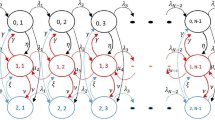Abstract
In this paper a novel algorithm is proposed to solve the problem of overload control in telephony signalling services. The new algorithm can provide better performance than the traditional ones and is developed for a control architecture containing a token bucket followed by a buffer. The behavior of the control loop is influenced by three parameters: (i) the token rate of a token-bucket restrictor denoted by r; (ii) the relative deadline of response times; and (iii) the zero point of the response times.
Our concern is to optimize the control parameter r to maximize a utility function defined by two parameters: the relative deadline and the zero point of response times. The optimal control is sought by solving a constrained optimization problem in which we maximize the throughput under the constraint of tolerating a given response time.
In this way, one can fulfill a pre-defined QoS criterion, while achieving optimal system performance. This optimization entails the evaluation of the queue length dynamics based on a 2D Markovian model. From this calculation the p.d.f. of the queue length and the system time is expressed and the QoS parameters are analytically calculated as a function of the control parameters. The optimal rate parameter can then be found by traditional optimization methods.
Similar content being viewed by others
References
Latouche, G., & Ramaswami, V. (1999). Introduction to matrix analytic methods in stochastic modeling. ASA-SIAM. ISBN 0-89871-425-7.
Lu, C., Stankovic, J.A., Son, S.H., & Tao, G. (2002). Feedback control real-time scheduling: framework, modeling, and algorithms. Journal of Real-Time Systems, 23, 85–126.
Stankovic, J.A., Ramamritham, K., & Towsley, D. (1991). Scheduling in real-time transaction systems. Technical Report: UM-CS-1991-046.
Abdelzaher, T., & Sharma, V. (2003). A synthetic utilization bound for aperiodic tasks with resource requirements. In: Euromicro conference on real time systems, Porto, Portugal.
Kleinrock, L. (1975). Queueing systems, Vol. I: Theory. Wiley Interscience, New York. ISBN 978-0471491101.
Andersson, M., Kihl, M., & Robertsson, A. (2003). Modelling and design of admission control mechanisms for web servers using non-linear control theory. In: Proceedings of information technologies and communications, Orlando, Florida, USA.
Abdelzaher, T.F., Shin, K.G., & Bhatti, N. (2002). Performance guarantees for web server end-systems: a control theoretical approach. IEEE Transactions on Parallel and Distributed Systems, 13(1), 80–96.
Fang, Y. (2001). Hyper-Erlang distribution model and its application in wireless mobile networks. Wireless Networks Archive, 7(3) (Special issue: Design and modeling in mobile and wireless systems).
Thümmler, A., Buchholz, P., & Telek, M. (2006). A novel approach for phase-type fitting with the em algorithm. IEEE Transactions on Dependable and Secure Computing, 3(3), 245–258.
Kasera, S., Pinheiro, J., Loader, C., LaPorta, T., Karaul, M., & Robust, A.H., (2005). Multiclass signaling overload control. In: Network Protocols, ICMP 13th IEEE international conference.
Robertsson, A., Wittenmark, B., & Kihl, M. (2004). Analysis and design of admission control in web-server systems. In: 43rd IEEE conference on decision and control, vol. 1, pp. 531–536.
Lin, H., Ghosh, P., & Das, P. (2006). Wireless networks revenue optimization overload control with priority services. Journal of Communications, 1(4).
Williams, P.M., & Whitehead, M.J. (2002). Realising effective intelligent network overload controls. BT Technology Journal, 20(3), 55–75.
Bobbio, A., Horváth, A., & Telek, M. (2005). Matching three moments with minimal acyclic phase type distributions. Stochastic Models, 21(2–3), 303–326.
Rosenberg, J. (2008). Requirements for management of overload in the session initiation protocol. Request for Comments 5390, IETF.
Whitehead, M. (2005). GOCAP—one standardised overload control for next generation networks. BT Technology Journal, 23(1), 147–153.
Seres, G., Szlávik, A., Zátonyi, J., & Bíró, J. (2003). Towards efficient decision rules for admission control based on the many sources asymptotics. Performance Evaluation 53(3–4), 209–223.
Author information
Authors and Affiliations
Corresponding author
Rights and permissions
About this article
Cite this article
Krupp, D., Levendovszky, J. Open-loop overload control algorithm for signalling traffic. Telecommun Syst 52, 387–396 (2013). https://doi.org/10.1007/s11235-011-9445-0
Published:
Issue Date:
DOI: https://doi.org/10.1007/s11235-011-9445-0




